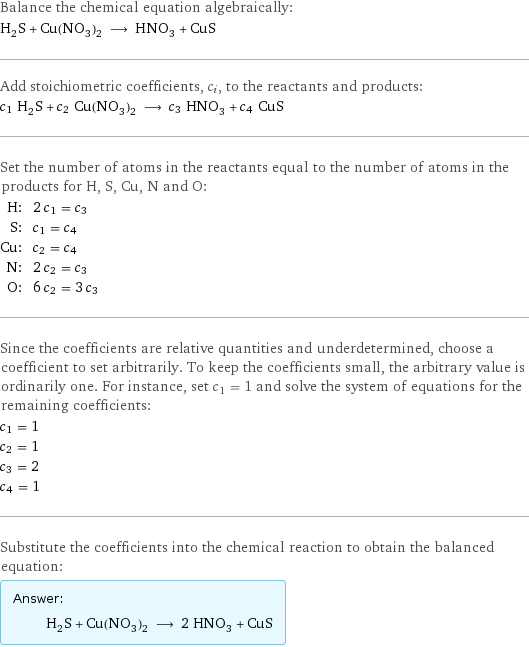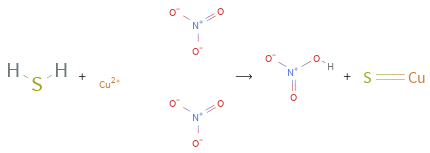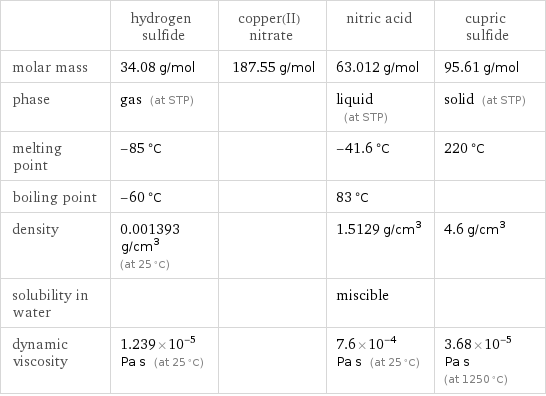Input interpretation

H_2S hydrogen sulfide + Cu(NO_3)_2 copper(II) nitrate ⟶ HNO_3 nitric acid + CuS cupric sulfide
Balanced equation

Balance the chemical equation algebraically: H_2S + Cu(NO_3)_2 ⟶ HNO_3 + CuS Add stoichiometric coefficients, c_i, to the reactants and products: c_1 H_2S + c_2 Cu(NO_3)_2 ⟶ c_3 HNO_3 + c_4 CuS Set the number of atoms in the reactants equal to the number of atoms in the products for H, S, Cu, N and O: H: | 2 c_1 = c_3 S: | c_1 = c_4 Cu: | c_2 = c_4 N: | 2 c_2 = c_3 O: | 6 c_2 = 3 c_3 Since the coefficients are relative quantities and underdetermined, choose a coefficient to set arbitrarily. To keep the coefficients small, the arbitrary value is ordinarily one. For instance, set c_1 = 1 and solve the system of equations for the remaining coefficients: c_1 = 1 c_2 = 1 c_3 = 2 c_4 = 1 Substitute the coefficients into the chemical reaction to obtain the balanced equation: Answer: | | H_2S + Cu(NO_3)_2 ⟶ 2 HNO_3 + CuS
Structures

+ ⟶ +
Names

hydrogen sulfide + copper(II) nitrate ⟶ nitric acid + cupric sulfide
Equilibrium constant
![Construct the equilibrium constant, K, expression for: H_2S + Cu(NO_3)_2 ⟶ HNO_3 + CuS Plan: • Balance the chemical equation. • Determine the stoichiometric numbers. • Assemble the activity expression for each chemical species. • Use the activity expressions to build the equilibrium constant expression. Write the balanced chemical equation: H_2S + Cu(NO_3)_2 ⟶ 2 HNO_3 + CuS Assign stoichiometric numbers, ν_i, using the stoichiometric coefficients, c_i, from the balanced chemical equation in the following manner: ν_i = -c_i for reactants and ν_i = c_i for products: chemical species | c_i | ν_i H_2S | 1 | -1 Cu(NO_3)_2 | 1 | -1 HNO_3 | 2 | 2 CuS | 1 | 1 Assemble the activity expressions accounting for the state of matter and ν_i: chemical species | c_i | ν_i | activity expression H_2S | 1 | -1 | ([H2S])^(-1) Cu(NO_3)_2 | 1 | -1 | ([Cu(NO3)2])^(-1) HNO_3 | 2 | 2 | ([HNO3])^2 CuS | 1 | 1 | [CuS] The equilibrium constant symbol in the concentration basis is: K_c Mulitply the activity expressions to arrive at the K_c expression: Answer: | | K_c = ([H2S])^(-1) ([Cu(NO3)2])^(-1) ([HNO3])^2 [CuS] = (([HNO3])^2 [CuS])/([H2S] [Cu(NO3)2])](../image_source/12b34e94d358393ed3015bb9de0510dd.png)
Construct the equilibrium constant, K, expression for: H_2S + Cu(NO_3)_2 ⟶ HNO_3 + CuS Plan: • Balance the chemical equation. • Determine the stoichiometric numbers. • Assemble the activity expression for each chemical species. • Use the activity expressions to build the equilibrium constant expression. Write the balanced chemical equation: H_2S + Cu(NO_3)_2 ⟶ 2 HNO_3 + CuS Assign stoichiometric numbers, ν_i, using the stoichiometric coefficients, c_i, from the balanced chemical equation in the following manner: ν_i = -c_i for reactants and ν_i = c_i for products: chemical species | c_i | ν_i H_2S | 1 | -1 Cu(NO_3)_2 | 1 | -1 HNO_3 | 2 | 2 CuS | 1 | 1 Assemble the activity expressions accounting for the state of matter and ν_i: chemical species | c_i | ν_i | activity expression H_2S | 1 | -1 | ([H2S])^(-1) Cu(NO_3)_2 | 1 | -1 | ([Cu(NO3)2])^(-1) HNO_3 | 2 | 2 | ([HNO3])^2 CuS | 1 | 1 | [CuS] The equilibrium constant symbol in the concentration basis is: K_c Mulitply the activity expressions to arrive at the K_c expression: Answer: | | K_c = ([H2S])^(-1) ([Cu(NO3)2])^(-1) ([HNO3])^2 [CuS] = (([HNO3])^2 [CuS])/([H2S] [Cu(NO3)2])
Rate of reaction
![Construct the rate of reaction expression for: H_2S + Cu(NO_3)_2 ⟶ HNO_3 + CuS Plan: • Balance the chemical equation. • Determine the stoichiometric numbers. • Assemble the rate term for each chemical species. • Write the rate of reaction expression. Write the balanced chemical equation: H_2S + Cu(NO_3)_2 ⟶ 2 HNO_3 + CuS Assign stoichiometric numbers, ν_i, using the stoichiometric coefficients, c_i, from the balanced chemical equation in the following manner: ν_i = -c_i for reactants and ν_i = c_i for products: chemical species | c_i | ν_i H_2S | 1 | -1 Cu(NO_3)_2 | 1 | -1 HNO_3 | 2 | 2 CuS | 1 | 1 The rate term for each chemical species, B_i, is 1/ν_i(Δ[B_i])/(Δt) where [B_i] is the amount concentration and t is time: chemical species | c_i | ν_i | rate term H_2S | 1 | -1 | -(Δ[H2S])/(Δt) Cu(NO_3)_2 | 1 | -1 | -(Δ[Cu(NO3)2])/(Δt) HNO_3 | 2 | 2 | 1/2 (Δ[HNO3])/(Δt) CuS | 1 | 1 | (Δ[CuS])/(Δt) (for infinitesimal rate of change, replace Δ with d) Set the rate terms equal to each other to arrive at the rate expression: Answer: | | rate = -(Δ[H2S])/(Δt) = -(Δ[Cu(NO3)2])/(Δt) = 1/2 (Δ[HNO3])/(Δt) = (Δ[CuS])/(Δt) (assuming constant volume and no accumulation of intermediates or side products)](../image_source/b8710153862c1624c9eb2d7cab8ecab2.png)
Construct the rate of reaction expression for: H_2S + Cu(NO_3)_2 ⟶ HNO_3 + CuS Plan: • Balance the chemical equation. • Determine the stoichiometric numbers. • Assemble the rate term for each chemical species. • Write the rate of reaction expression. Write the balanced chemical equation: H_2S + Cu(NO_3)_2 ⟶ 2 HNO_3 + CuS Assign stoichiometric numbers, ν_i, using the stoichiometric coefficients, c_i, from the balanced chemical equation in the following manner: ν_i = -c_i for reactants and ν_i = c_i for products: chemical species | c_i | ν_i H_2S | 1 | -1 Cu(NO_3)_2 | 1 | -1 HNO_3 | 2 | 2 CuS | 1 | 1 The rate term for each chemical species, B_i, is 1/ν_i(Δ[B_i])/(Δt) where [B_i] is the amount concentration and t is time: chemical species | c_i | ν_i | rate term H_2S | 1 | -1 | -(Δ[H2S])/(Δt) Cu(NO_3)_2 | 1 | -1 | -(Δ[Cu(NO3)2])/(Δt) HNO_3 | 2 | 2 | 1/2 (Δ[HNO3])/(Δt) CuS | 1 | 1 | (Δ[CuS])/(Δt) (for infinitesimal rate of change, replace Δ with d) Set the rate terms equal to each other to arrive at the rate expression: Answer: | | rate = -(Δ[H2S])/(Δt) = -(Δ[Cu(NO3)2])/(Δt) = 1/2 (Δ[HNO3])/(Δt) = (Δ[CuS])/(Δt) (assuming constant volume and no accumulation of intermediates or side products)
Chemical names and formulas

| hydrogen sulfide | copper(II) nitrate | nitric acid | cupric sulfide formula | H_2S | Cu(NO_3)_2 | HNO_3 | CuS Hill formula | H_2S | CuN_2O_6 | HNO_3 | CuS name | hydrogen sulfide | copper(II) nitrate | nitric acid | cupric sulfide
Substance properties

| hydrogen sulfide | copper(II) nitrate | nitric acid | cupric sulfide molar mass | 34.08 g/mol | 187.55 g/mol | 63.012 g/mol | 95.61 g/mol phase | gas (at STP) | | liquid (at STP) | solid (at STP) melting point | -85 °C | | -41.6 °C | 220 °C boiling point | -60 °C | | 83 °C | density | 0.001393 g/cm^3 (at 25 °C) | | 1.5129 g/cm^3 | 4.6 g/cm^3 solubility in water | | | miscible | dynamic viscosity | 1.239×10^-5 Pa s (at 25 °C) | | 7.6×10^-4 Pa s (at 25 °C) | 3.68×10^-5 Pa s (at 1250 °C)
Units
